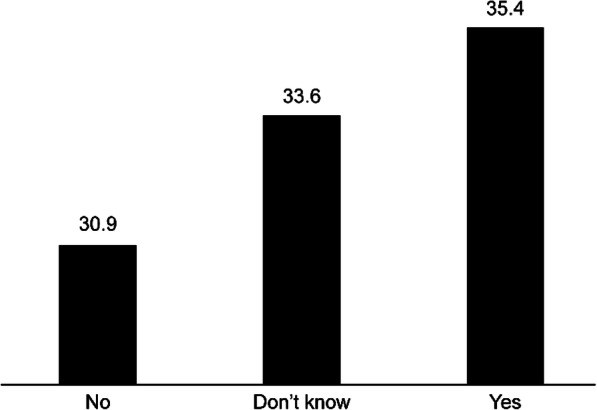An exploratory study of public' awareness about robotics-assisted surgery in Kuwait
Affiliations
Affiliations
- Department of Community Medicine & Behavioral Sciences, Faculty of Medicine, Kuwait University, P.O. Box 24923, 13110, Safat, Kuwait. ali.buabbas@hsc.edu.kw.
- Department of Surgery (Urology Division), Faculty of Medicine, Kuwait University, P.O. Box 24923, 13110, Safat, Kuwait.
- Department of Immunology, Mubarak Alkabeer Hospital, Hawally Health Region, Ministry of Health, Jabriya, Kuwait.
Abstract
Background: The adoption of robotic-assisted surgery (RAS) requires a clear willingness, not only from healthcare organization to operate the robotic system but also from the public that is going to perceive it. This study aims to explore public's awareness, understanding and their perceptions towards RAS in Kuwait.
Methods: This cross-sectional study used a survey questionnaire that was disseminated on a tablet device to people at their convenience in governmental institutions.
Results: A total of 1087 people agreed to participate in this study. The study results showed that only 36.8% of respondents had heard of RAS and 27.1% knew what RAS is. Moreover, 47.6% of the respondents were uncertain about its safety, while 29.7% thought RAS was safe. The results also showed that 40.9 and 34.4% of respondents thought that RAS is more precise and faster than conventional surgical procedures, respectively, whereas 30.6% feared malfunctioning issues during surgical procedures.
Conclusion: This public survey among a Middle Eastern population reveals lack of awareness and limited understanding of RAS. However, there was a tendency towards believing that RAS may have potential advantages in terms of better outcomes compared to conventional surgical procedures.
Keywords: Awareness; Perceptions; Public; Robotic-assisted surgery.
Conflict of interest statement
The authors declare that they have no competing interests.
Figures
Similar articles
Aldousari SA, Buabbas AJ, Yaiesh SM, Alyousef RJ, Alenezi AN.J Robot Surg. 2021 Aug;15(4):529-538. doi: 10.1007/s11701-020-01136-w. Epub 2020 Aug 10.PMID: 32776285
Online Crowdsourcing to Explore Public Perceptions of Robotic-Assisted Orthopedic Surgery.
Pagani NR, Moverman MA, Puzzitiello RN, Menendez ME, Barnes CL, Kavolus JJ.J Arthroplasty. 2021 Jun;36(6):1887-1894.e3. doi: 10.1016/j.arth.2021.02.027. Epub 2021 Feb 15.PMID: 33741241
Awad A, Al-Shaye D.BMC Complement Altern Med. 2014 Mar 19;14:105. doi: 10.1186/1472-6882-14-105.PMID: 24646341 Free PMC article.
Robot-assisted surgery in gynaecology.
Liu H, Lawrie TA, Lu D, Song H, Wang L, Shi G.Cochrane Database Syst Rev. 2014 Dec 10;2014(12):CD011422. doi: 10.1002/14651858.CD011422.PMID: 25493418 Free PMC article. Updated. Review.
Advantages of robotics in benign gynecologic surgery.
Truong M, Kim JH, Scheib S, Patzkowsky K.Curr Opin Obstet Gynecol. 2016 Aug;28(4):304-10. doi: 10.1097/GCO.0000000000000293.PMID: 27362711 Review.
Cited by
Telerehabilitation during the COVID-19 Pandemic: Patients and Physical Therapists' Experiences.
Buabbas AJ, Albahrouh SE, Alrowayeh HN, Alshawaf H.Med Princ Pract. 2022;31(2):156-164. doi: 10.1159/000523775. Epub 2022 Feb 24.PMID: 35203079 Free PMC article.
Türkay S, Letheren K, Crawford R, Roberts J, Jaiprakash AT.J Robot Surg. 2022 Jun;16(3):621-629. doi: 10.1007/s11701-021-01287-4. Epub 2021 Jul 27.PMID: 34312804
KMEL References
References
-
- Platis C, Zoulias E. (2014) Impacts of robotic assisted surgery on Hospital’s strategic plan. Procedia Soc Behav Sci. 2014;147:321–326. doi: 10.1016/j.sbspro.2014.07.101. - DOI
-
- Zhang SS, Ding T, Cui ZH, Lv Y, Jiang RA. Efficacy of robotic radical hysterectomy for cervical cancer compared with that of open and laparoscopic surgery: a separate meta-analysis of high-quality studies. Medicine (Baltimore) 2019;98(4):e14171. doi: 10.1097/MD.0000000000014171. - DOI - PMC - PubMed
-
- Zineddine M, Arafa N. Attitude towards Robot Assisted Surgery: UAE context 2013 9th International Conference on Innovations in Information Technology (IIT), Abu Dhabi. 2013. pp. 175–179.
-
- Boys JA., Alicuben E.T., DeMeester MJ., Worrell SG., Hagen JA., DeMeester SR. Public perceptions on robotic surgery, hospitals with robots, and surgeons that use them, Surg Endosc 2016;30:1310–1316. 10.1007/s00464-015-4368-6. - PubMed
-
- Gilbert C., Kechris D., Marchese A., Pelletier E. An interactive qualifying project submitted to the faculty of Worcester polytechnic institute. https://web.wpi.edu/Pubs/E-project/Available/E-project-042710-145052/unr..., 2010 (accessed 28 June 2018).
-
- Ahn K, Donnellan N, Lee T. Patient perception of robotic surgery in gynecology. J Minim Invasive Gynecol. 2014;21(6):71. doi: 10.1016/j.jmig.2014.08.251. - DOI
-
- Kuo IH, Rabindran JM, Broadbent E, Lee YI, Kerse N, Stafford RMQ. Age and gender factors in user acceptance of healthcare robots, in: RO-MAN 2009 - the 18th IEEE international symposium on robot and human interactive communication. Toyama: IEEE; 2009. pp. 214–219.


